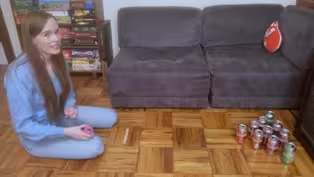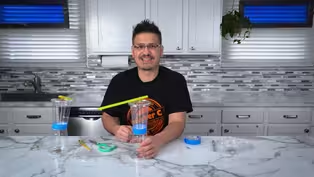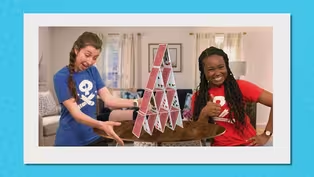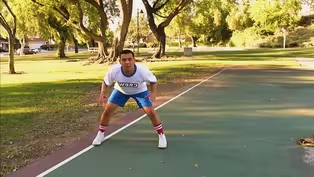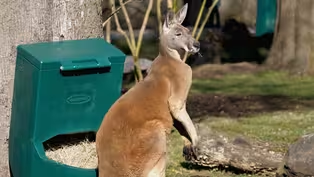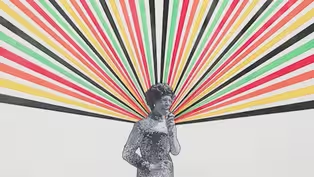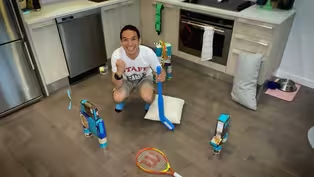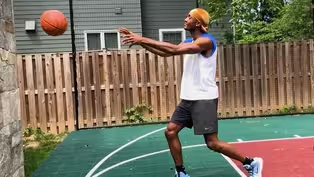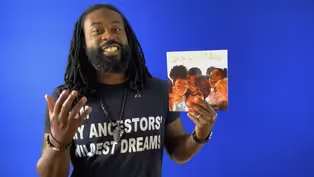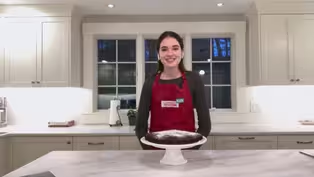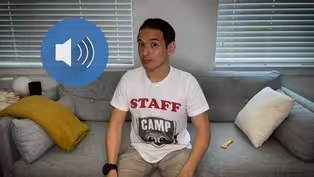
Sports Day (Long Version)
6/30/2021 | 56m 56sVideo has Closed Captions
Play mini-golf, mini-football, and mini-bowling!
Join head counselor Zach to play mini-golf, mini-football, and mini-bowling! Make a racer from cups, learn to steal a base, meet kangaroos and rhinos. Content partners include America’s Test Kitchen Kids, Children’s Museum of the Arts, Memphis Zoo, OK Go, One Voice Children’s Choir, San Diego Zoo, S’More Ideas, Story Pirates.
Problems playing video? | Closed Captioning Feedback
Problems playing video? | Closed Captioning Feedback
Camp TV is a local public television program presented by THIRTEEN PBS

Sports Day (Long Version)
6/30/2021 | 56m 56sVideo has Closed Captions
Join head counselor Zach to play mini-golf, mini-football, and mini-bowling! Make a racer from cups, learn to steal a base, meet kangaroos and rhinos. Content partners include America’s Test Kitchen Kids, Children’s Museum of the Arts, Memphis Zoo, OK Go, One Voice Children’s Choir, San Diego Zoo, S’More Ideas, Story Pirates.
Problems playing video? | Closed Captioning Feedback
How to Watch Camp TV
Camp TV is available to stream on pbs.org and the free PBS App, available on iPhone, Apple TV, Android TV, Android smartphones, Amazon Fire TV, Amazon Fire Tablet, Roku, Samsung Smart TV, and Vizio.
Providing Support for PBS.org
Learn Moreabout PBS online sponsorship- Hi everybody.
My name is Zach and welcome to Camp TV.
Are you ready for some summer fun?
Me too.
[chuckles] Now, as your head counselor, I will be introducing you to all sorts of cool activities.
Arts, crafts, games, math and science, as well as some of my favorite books, nature and theater.
I will be here to take you from one activity to the next.
So follow me on Camp TV.
- [Narrator] This program was made possible in part by the Corporation for Public Broadcasting, a private corporation funded by the American people.
Additional funding was provided by the Peter G. Peterson and Joan Ganz Cooney fund, and the Pine Tree Foundation of New York.
[light guitar music] ♪ Camp TV ♪ ♪ It's time for us to start ♪ ♪ From fury animal encounters ♪ ♪ To summer beading and the arts ♪ ♪ No matter what the weather ♪ ♪ We'll explore it all together ♪ ♪ It's a place for you and me ♪ ♪ It's Camp TV ♪ [whistle blows] - Zach with the ball, with 10 seconds left on the clock.
He fits, he pivots, he shoots.
He scores.
[cheering] Well, that is a rough, rough way to end the game.
Maybe I should move on to something else.
[baseball theme music] Hey Scout!
[sighs] [upbeat music] Well, well, well, looks like we're not much of a team player huh?
Well, we will have to figure something out, because today is sports day on Camp TV.
Maybe I can take up cycling?
No?
Have fun at your first few activities.
It's time to get active, let's move.
- Oh hey, Ross here.
I'm just having a little pass workout with my buddy, Waldo.
Waldo, meet everyone, everybody, meet Waldo.
Waldo and I have been buddies for about 13 years now, ever since I started playing basketball.
Because when I couldn't get anybody else to go outside and play with me, Waldo was always there for me.
Thanks, Waldo.
What you need for a good pass is a good step and good arms.
Check it out.
I want you to step forward, raise the ball to your chest, extend your arms.
Once they're fully extended, release.
Now watch me play a game of pass with my good friend, Waldo.
Step, chest, arms, release.
Step, chest, arms, release.
Step, chest, arms, release.
[ball thudding] If you want to challenge yourself, you can take a couple steps back.
Just don't forget the fundamentals.
Step, chest, arms, release.
Step, chest, arms, release.
Step, chest, arms, release.
Step, chest, arms, and release.
You guys got it?
Not go outside and work on your passing.
If you don't have a wall to throw to, but you do have a parent, sibling, friend, or even your nana to pass to, go work on it with them.
Try passing it 50 times, taking a little water break, then 50 more times.
See you guys later.
[cheering] - [Zach] A little birdie told me it's time to go wild.
- Hi friends, my name is Aliana, I'm an animal interpreter here at the Memphis zoo in Memphis, Tennessee.
As an animal interpreter, I get to share my knowledge and the stories of all the animals here at the zoo with you all.
Today is a very exciting day, because we are going to be learning all about there mighty red kangaroo.
Red kangaroos are native to the open plains and grasslands of Australia, and they are the world's largest living marsupial.
A marsupial is a mammal that has a pouch on its body where its babies will grow up.
That's because marsupials are born before they're finished developing, and are about the size of a jellybean.
They will finish growing and nursing all mom's milk all in that pouch until they are ready to begin venturing out into the world.
For a baby red kangaroo, that's about eight months.
A few other Australian marsupials include koalas and wallabies.
Red kangaroos get their name because the males tend to have a distinct reddish brown coat color.
The females, however, tend to be more grayish blue in color.
Red kangaroos are herbivores, which means they primarily eat plant matter.
Out in the wild in Australia, they would primarily be grazing on grasslands, shrubs, and leaves.
Here at the zoo, they get a diet of specially made pellets just for them and lots and lots of fresh hay.
In order to help them survive, red kangaroos have several special adaptations.
They have large, powerful, hind legs to help them bound across the plains.
They can cover up to 25 feet in a single leap and can reach speeds of over 35 miles per hour.
In addition to those strong legs, red kangaroos have a long, muscular tail that helps them keep their balance.
Aside from being some of the most recognizable and eye catching features of red kangaroos, these adaptations are crucial for helping them get away from threats like predators or wildfires.
Red kangaroos also have some tricks for keeping cool in the heat of Australia.
They often spend the hottest part of the day resting or sleeping and wait until cooler hours, like night or morning, to graze and do other activities.
They can also sweat and pant to help them expel heat.
Another animal that pants to expel heat is a dog.
Red kangaroos are amazing animals, and it's easy to be fascinated by them.
But would you believe me if I told you we have our own amazing marsupial that we could find right here in our backyards in the United States?
This is Ross, and and he is a Virginia opossum.
Virginia opossums are widely distributed throughout the US, and they are marsupials just like red kangaroos.
That means that female opossums have a pouch just like kangaroos to rear their young in.
However, the Virginia opossums pouches are vertical on their stomach rather than horizontal, because when they're climbing up in the trees, they are able to close that vertical pouch to make sure that their babies don't fall out.
While opossums don't have a thick, muscular tail like a red kangaroo, they do have their own specially adapted tail.
Opossum's tails are prehensile, which means finger-like.
Their tail is perfectly adapted for wrapping around branches to help them keep their balance in the trees.
This makes opossums excellent climbers.
So we may not have red kangaroos here in the US, but we have another marsupial that is just as fascinating that we can learn all about.
Like we learned earlier, red kangaroos are herbivores, but Virginia opossums here are omnivores, which means that they eat both plant and animal matter.
However, opossums will eat pretty much anything they can find, which means they can sometimes end up in situations that aren't very good for them.
We can do something really easy to help out Virginia opossums, since they do live really close to us here in the United States.
By making sure that one, we dispose of our trash properly, and two, we make sure that our trashcan lids are nice and secure.
Today the Virginia opossum taught us that the ordinary can be extraordinary through the right lens.
And while red kangaroos might not live in our backyards, there are still ways that we can help them.
By visiting reputable zoos, like the Memphis zoo, you help support the conservation work and research that they do to help animals all over the world.
We can also help make the world a better place for all animals, including the opossum and red kangaroo, by reducing the amount of trash that we make.
We can do that by doing simple things, like using a reusable water bottle, using reusable grocery bags when we go to the grocery store, and lots of other things that you can probably think of on your own.
Well friends, it looks like that's all the time that we have for today.
But on behalf of myself, the red kangaroos, Virginia opossums, and all the animals and us here at the Memphis zoo, I want to thank you guys for learning with us today.
Bye.
- Welcome back, campers.
Hope you got a kick out of your last activity.
Rolling right along, who's ready for a Zach challenge?
I'm putting my kitchen to better use as a homemade putt putt range.
Really it's no less messy than when I cook.
I will have 15 seconds to get the ball rolling over, under and around this obstacle course.
Let's do it.
Go, go, go, go, go, go.
Okay, go, go, go, yeah, yeah.
Go, go, go, yeah.
Oh my God, oh gosh, oh gosh.
[buzzer sounds] Yes, it's in there.
Yes, I just made it!
The thrill of victory.
Have a ball at your next activity.
Music, dance, magic, and more.
Step right up to center stage.
- Two, three, four.
♪ Try everything ♪ ♪ Try everything ♪ ♪ Oh yeah ♪ ♪ I messed up tonight ♪ ♪ I lost another fight ♪ ♪ I so messed up but I'll start again ♪ ♪ I keep falling down, I keep on hitting the ground ♪ ♪ I always get up and see what's next ♪ ♪ Birds don't just fly, they fall down and get up ♪ ♪ Nobody learns without getting it wrong ♪ ♪ I won't give up, no I won't give in ♪ ♪ Until I reach the end, then I'll start again ♪ ♪ No I won't leave, I want to try everything ♪ ♪ I want to try even though I could fail ♪ ♪ I won't give up ♪ ♪ No, I won't give in ♪ ♪ Until I reach the end, then I'll start again ♪ ♪ No I won't leave, I want to try everything ♪ ♪ I want to try even though I could fail ♪ ♪ Look how far you've come ♪ ♪ You filled your heart with love ♪ ♪ Baby you're strong enough ♪ ♪ Take that deep breath ♪ ♪ Don't beat yourself up ♪ ♪ No need to run so fast ♪ ♪ Sometimes we come last ♪ ♪ But we did our best ♪ ♪ I won't give up ♪ ♪ No, I won't give in ♪ ♪ Until I reach the end, then I'll start again ♪ ♪ No I won't leave, I want to try everything ♪ ♪ I want to try even though I could fail ♪ ♪ I won't give up ♪ ♪ No I won't give in ♪ ♪ Until I reach the end, then I'll start again ♪ ♪ No I won't leave, I want to try everything ♪ ♪ I want to try even though I could fail ♪ ♪ I'll keep on making those new mistakes ♪ ♪ I'll keep on making them every day ♪ ♪ Those new mistakes ♪ ♪ I won't give up ♪ ♪ No I won't give in ♪ ♪ Until I reach the end, then I'll start again ♪ ♪ No I won't leave, I want to try everything ♪ ♪ I want to try even though I could fail ♪ ♪ I won't give up ♪ ♪ No I won't give in ♪ ♪ Until I reach the end, then I'll start again ♪ ♪ I won't leave, I want to try everything ♪ ♪ I want to try even though I could fail ♪ ♪ I won't give up ♪ - [Zach] Curiosity and wonder, let's discover together.
It's science wow!
- Hi everybody, It's Mr. C, and I'm so excited to be doing a super duper science experiment with you today.
We're actually going to be building DIY race cars, yeah.
Whoa!
[laughs] Did you see that?
This is the car that we're going to be building, with some cups, rubber bands, and straws.
Vroom!
So we need some simple materials in order to make this work.
We need some plastic cups, paper cups, doesn't matter what kind of cups, but you'll needs lids with them.
We'll need a pair of scissors.
I have two paperclips, I have a little push pin so that I can actually put a hole into my cups and get that started.
I've got two little pieces of cardboard that are going to be used as stoppers.
I have a hex nut and a pony bead.
And I also have some tape, a marker, a pencil, and most importantly, a straw.
First things first, take your marker, and what we're going to do is we're going to mark the center, or as close to the center as we can, with our marker.
Then we're going to use the pushpin to put a hole right in the center.
You want to be careful with this because it is a sharp little pointy needle.
If you need help, have a grown up help you.
Once you have those two holes in there, you're also gong to put a hole into the cardboard right in the center, and you're going to do that with both pieces.
So then what we're going to do is we're going to take our pencil and you're going to use the pencil to make the hole bigger.
Perfect, so we have two holes in our cardboard.
And now we're going to try that with our plastic cup also.
I just need to get that hole a little bit bigger.
Oh, it broke my pencil.
So if you have to use your scissors, have a grown up help you.
But basically I'm just going to, there's an existing hole, I'm going to just twist, go nice and slow, it'll work through.
Once it goes in, you're just going to kind of twist it to make it bigger.
There we go, nice and big.
That gives us lots of space to move the rubber band through, and then we're going to repeat that on the second cup.
All right, once we get that in there, make the hole nice and big, because what we're going to do is we have to stack these up.
And once we tape that together, those holes should line up pretty well so that the rubber band can go through without hitting the plastic.
It looks like it's ready to go, so we're going to take a nice, long piece of tape.
I'm going to turn this on its side, and I'm going to tape all the way around.
Perfect.
As you can see, the hole goes straight through.
And now, this is probably the most difficult part.
We're going to take these two rubber bands, and I'm going to lay one underneath it, and then I'm going to fold it through itself, and pull it back out.
So basically what I'm doing is I'm putting a knot in the rubber band and now I have one long stretchy rubber band.
So I doubled its length.
And we're going to put that through one side.
Now you're going to grab a lid, and you're going to put the rubber band through the opening of the lid, through the cardboard.
And then what you're going to do is take a paperclip and you're going to hook the paperclip through like this, so that when we apply pressure, the rubber band can't come out, all right?
Then we have to push that rubber band through the hole, this gets tricky.
Use your pencil to push it through, and then from the other side, grab it.
Yes, I did it!
I'm going to push that closed.
And now we have to do the same thing on the other side, we've got to put this through the lid, and now there's a lot of tension.
All right, there we go.
Close that, got it.
Take our cardboard again, push the rubber band through the cardboard.
And now what I'm going to do is I'm going to take, I like a little hex nut, and then I have this little bead, plastic bead, I'm going to put it over this also.
Just because I want to have, I want to get this straw to be past the lip of the cup.
Once I have those stacked on each other, I'm going to take my straw, and once you get it in here, finally, we're safe, we can breathe.
Look at that, it's a race car.
And you're wondering, where does it get it's power from, where does it get its energy from?
Well it's all about the rubber band.
This rubber band, when we spin it, it starts to store energy inside the cup, well inside the rubber band, which is inside the cup.
And soon it'll be racing on our table.
You're going to spin this over and over and over.
The more you spin it, you'll start feeling that the rubber band is getting to be tighter to twist.
More tension is building up.
And all that stored energy is going to be what drives our car across the street, or across the table, or across your kitchen floor.
Or outside in your driveway.
And when you put it down.
[laughs] I thought it was gonna go that way.
So now when I put it down, I did it again.
So now when I put it down, that's so cool.
How awesome is that?
You can build one of these also with a few simple materials that you already have at your house.
That's what I love about doing science in my kitchen right here, because I can show you all the cool things that you could do in your house with materials you probably already have.
Now, if you want to try something different, try different sized cups, try thicker rubber bands, try longer rubber bands.
Change some variables, have some fun, and before you know it you'll be racing all around.
Thanks for hanging out with me today.
What a fun camp experiment, right?
See you later, bye!
- [Zach] Arts and crafts?
Yes, please, let's get artsy.
- Hi everyone, it's Mackie from the Children's Museum of the arts in New York City.
Today we are talking about light.
Sometimes light can guide our path, it can tell us when to stop and go, and sometimes light can also be a feeling.
A feeling of hope and weightlessness, and that feeling we get when we share our strengths and gifts with others.
When things get dark and gloomy, poet Maya Angelou reminds us, nothing can dim the light that shines from within.
How will you share your light with the world?
First we're going to look at a piece of art, and then we're going to make an art project inspired by that artwork.
And finally, we'll share our artwork that we created.
So let's get started.
You know that feeling of energy and hope I mentioned earlier?
That's how I feel when I look at Rico Gatson's icon series.
When I look at a piece of art, I like to first take in the whole thing.
So let's look.
What do you see?
[light music] I see a few things.
First my eye is immediately drawn to these big, colorful lines that go across the whole page, except for this small image down here.
To me it looks like a photo, and it's in black and white, so maybe it's an old photograph?
Once I've looked at an artwork as a whole, I like to go back and look for small details to see what I notice or what questions I might have.
So let's look again.
What do you notice this time?
[light music] After getting a closer look, I noticed some other things.
First I recognize the colors, black, green, red, orange, and yellow in the lines that were used.
And I wondered, if the artist had all the colors of the rainbow to choose from, why did they choose these colors?
That must mean they're important.
Plus I notice that all these lines are coming from this central image.
They started smaller when they're connected to the image and grow bigger as they grow out on the page.
And when I was looking closer at that image, I realized who it was.
Shirley Chisholm, the first black women elected to United States Congress and a Representative from right here in New York.
I notice that she's holding a microphone, so maybe she's saying something important.
This artwork is a parr of Rico Gatson's icon series, in which he honors the many important meaningful and powerful people in black culture.
The people in these artworks use their strengths and power, their inner light, to bring hope, joy, and make an impact in their world.
Rico Gatson also did a related installation in the bridge, one of CMAs exhibition spaces.
Installation is a kind of art that transforms a space and the way you perceive it.
Rico Gatson's You Are Light uses beams of light and color as a metaphor for positive energy, power, and hope for a better future.
The cool thing is the artwork is completed when you, the viewer, stand in it.
What are your strengths, and what makes you feel powerful?
Let's explore as we make an art project inspired by the work of Rico Gatson.
So I've been thinking, artist Rico Gatson asks us to honor and uplift the people in his artwork, not just for their recognizable image, but more so because of their enduring light and impact they've had on us and our culture.
They made this impact by sharing their strength and power with the world.
I don't know about you, but I haven't been feeling very strong or powerful lately.
There's a lot of things in the world right now that are kind of scary.
And when it's raining outside, it's hard to see the light.
But then I remembered, the figures in these artworks don't have light shining down on them.
They create the light themselves.
Nothing can dim the light that shines from within.
So I wanted to make a project today where we explore our own inner light.
Our strengths and our powers, so that no matter what, even on the darkest days, our inner light can brighten our homes and our communities.
So let's begin.
Today you'll just need a few things for your artwork.
We'll start out with paper, pencils, drawing materials like colored pencils or crayons, scissors, and glue.
You're also welcome to use colored paper and collage materials if you'd like.
We'll begin by drawing an image of ourselves, a self portrait.
You can use drawing materials, you can cut our pictures from magazines, or use a real photograph of yourself.
You decide.
As you're creating, think about what your light is that you can share with the world.
What makes you a good friend, what are you proudest of?
Don't forget to make your self portrait small so it can fit on the page with all the big colorful lines of light.
Here's the image I made.
When I was thinking about my strengths and powers, I thought about how I love to learn and I love to grow.
So in my image, which I kept small, to fit on my page, I included flowers as a symbol of growth and change, and I also am wearing my CMA shirt, a place where I love to learn.
As you're creating, don't forget to think about where this light comes from.
Shirley Chisholm's came from her big, powerful voice.
Charlie Parker's from his instrument, and Mohammad Ali's from his fist.
Where will yours come from?
Your powerful mind, your kind heart, your helping hands?
When you have your self portrait complete, it's time to add your light.
What colors are you going to use?
You decide what colors you'd like to share your strength and power with the world.
I also chose to cut out my self portrait and glue it on top of my page with lines.
And so now that that's all done, here is my final self portrait.
And now it's time for our share.
Hang your light portrait in a place you'll see it every day, and don't forget to keep sharing your light with the world.
It'll brighten your home and make our community a better place to be.
- Hi, being that it's sports day on Camp TV, I thought a little healthy competition might be fun.
So who's ready for a you challenge?
See if you can figure out what sports these are by listening to the sounds they make.
Here, let me show you.
[thumping] You hear that?
Let's listen again.
[thumping] Sounds like basketball to me.
Let's see if we're right.
[ball thumping] Yes, the answer is basketball.
Okay, now the ball is in your court.
Ready?
What sport is this?
[running] [tinkling] Any guesses?
If you said tennis, you're right!
Okay, ready for another one?
Let's listen.
[rolling] [clinking] Oh, strike!
If you said bowling, you're right.
Okay, how about this?
[stadium music playing] What do you think?
If you said baseball, home run!
Okay, last one.
This one might be a little more tricky.
Ready?
[water splashing] Go ahead, don't be afraid to dive in.
If you said swimming, you are right.
Good job, you good sport.
See you after your next activity.
Ready for some math that counts?
Count on.
- Hi, my name is Nora.
And today I'm going to show you one of my favorite math games to play at home.
Have you ever gone bowling?
Well now you can get your bowl on at home, no borrowed shoes required.
And you can practice counting by fives and tens along the way.
It's time to bowl for the goal.
Let's do it.
To play this game you only need to gather up some empty cans or bottles around your house.
You can use any different kind that you might have.
I have 10 different cans for my game.
Make sure that they're empty and clean, or you'll have a pretty big mess on your hands.
You'll also need some tape, a ball, or you can make your own ball by just rolling up a sock that you have at home.
And somewhere to keep track of your score, like a piece of paper and a marker or pen or pencil.
Okay, now we have to set up our bowling pins, or for me, these empty cans.
So normally when you bowl, each pin you knock down is worth one point.
But for our game, we have pins that are worth different kinds of points.
So we're going to have some pins that are worth five points, some pins that are worth 10 points, and two extra special pins that are worth 100 points each.
Okay, so I need to mark which cans, or pins, are which amount of points.
So I'm going to pick three cans to be five points, and you could paint the entire can a certain color if you wanted or if you have colored paint, you could use that.
But for me, I'm just going to use this regular masking tape that I have and wrap it around the can, and then I'm just going to color that.
So I'm going to color my five point pins red.
And I'm going to mark those with a five.
[upbeat music] Now I need five pins that are worth 10 points, so I'm going to do the same thing with my tape, but I'm going to color these pins blue, and put a 10 on them.
[upbeat music] And my last two pins are each worth 100 points, and these two, they're already green, but I'm going to do the same thing, I'm going to add a piece of tape and color that green, so I make sure I know which ones are my 100 point cans.
[upbeat music] Okay, all my pins are ready, let's set them up.
Here's how I set up my pins.
I used the same triangle shape that you'd see at a bowling alley.
I started with one five point pin in the front, and then I put two five point pins on either side in the row right behind the first one.
And then in the third row, I put three 10 point pins, and in the last row, I put two 10 point pins in the middle, and my 100 point pins on the outside.
You can play around with different pin configurations, different shapes, different setups as you go as well.
Now, let's bowl.
I put a piece of tape down on the floor to show me the line I have to stay behind while I roll my ball.
And if you have more space, maybe you could do this standing up, like if you were outside.
But since I have a small space, I'm going to bowl sitting down, and I'm just going to roll my ball along the floor to try to knock down as many pins as I can.
Let's give it a shot.
Okay, here we go.
In three, two, one.
I got a couple, let's count them up.
Let's see, I'm going to count up my points as I go here.
I see I knock down five, ten, looks like that's all my five point pins, so that's a total of ten points.
And then the 10 point pins, 10, 20, okay that's all my 10 point pins.
And then my 100 point pins, I got 100, 200.
So if we add all of those points together, we have 10 plus 20 plus 200.
That gives us 230 points total.
Great.
I think that was pretty good for a first try.
You can try this at home, too.
Either by yourself and see how many rounds it takes you to get 500 or 1,000 points.
Or play with a friend or a family member.
Take turns throwing the ball and see who can get the most points overall.
Well, I hope you had a ball playing.
Get it?
I'll see you next time, bye.
- [Zach] It's time to get active, let's move.
- Frankie here, hope you're ready to be set apart from other players.
Are you ready?
I think you are.
What we're going to do is steal some bases.
All you need is yourself, you can do this indoors or outdoors.
I'm outdoors, obviously.
Do whatever's best for you.
All you need is something to put on the ground for a base.
Let's get to it.
What we're going to do is steal some bases.
Let's head over to our home made base.
Right, left, we're stepping out, we're looking around, now we're turning, side step.
Still looking around, still looking at the action.
All right, let's start heading over, get back to that base.
Right, left, turn, oh, do not shuffle over.
Shuffling will get you out.
Let's do this the correct way.
Ready?
Stepping out right, left, turn, side step, side step, still looking around, still looking at that ball.
Go back to that base, and do it again.
Stepping out, right, left, turn, side step, side step.
Looking at the action, looking at the pitcher, all right, go back to that base again.
Right, left, turn, side step, side step, go back to that base.
Let's do this one last time.
Right, left, turn, side step, side step, all right, good job.
Now it's your turn, go outside, stay indoors, do whatever you gotta do.
Go for 15 minutes doing this, take a break, then go for another 15.
Because practice makes pros.
Adios amigos.
- [Zach] You took the words right out of my mouth, write on.
[triumphant music] - If you've seen any of our other hero videos, then you already know about my personal favorite hero, Dr. Bad Jokes.
The hero who can solve any problem by telling a really, really terrible joke.
Black out in New York City, who will save the day?
Could Dr. Bad Jokes somehow tell a joke bad enough to get the lights back on?
- Hey knock knock.
Who's there?
The lights, the light's who?
That's what I'm saying.
[booing] - Wow, that joke was so bad, it turned all the lights back on in Time Square.
Thank you, Dr. Bad Jokes.
- You know, the other day I was walking around and I saw this guy who looked exactly like Dr. Bad Jokes, except he wasn't saving people or solving a huge problem.
He was just sitting on a park bench reading a comic book.
And I started to be afraid, has Dr. Bad Jokes stopped being a hero?
- Clinton, of course I'm still Dr. Bad Jokes.
It was my day off.
Heroes can have days off, too, you know.
And on my day off, on a regular day, I like to relax and read comic books.
Is that okay?
I mean, Clinton, you do things on your day off, right?
You don't just stand around talking to a camera all day, do you?
- Yeah, okay, sorry, I'm embarrassed.
Sometimes even heroes need a normal day where they're not solving the world's problems.
My bad.
- Hey, that reminds me of a joke.
Did you hear the one about the sheep?
My bad, I forgot the joke.
[booing] - Actually this could be a great way to make your hero more real and interesting to the reader.
Give them some hobbies, write about the soccer game they played with their little cousin or what kind of food they like or what they do around the house.
Once the big problem comes along in your story, they're going to have to put down the comic book or kick away the soccer ball or leave their dinner unfinished anyway, but in the mean while, it's nice for the reader to get to know your hero a little bit more as a person and see what they're really like before they're out there solving problems.
- One thing that I love about sports is no matter where in the world you live, what language you speak, or how old you are, it can bring families, old friends, and new friends, together.
But it's not always possible to get to get to a sports arena these days, so I say, let's bring the stadium to us.
You will need some green and brown construction paper, some chalk, a ruler, some craft sticks, some mini clothes pins, some gray paint, and a paint brush, and some glue.
First, paint three craft sticks and a clothes pin gray.
Once they're dry, glue the craft sticks together to create the top of the goal post.
Clip to the clothes pin.
Next, using a ruler and chalk, draw 10 yard lines from 10 to about 30 or 40 on the green construction paper.
10, 20, 30, and 40.
Next, set up the goal post in the end zone.
The clothes pin should be able to stand on its own, but if you want some reinforcement, you can use a small piece of clay at the base.
Last step, crumple up a piece of the brown construction paper into a ball and have fun trying to flick it through for field goal.
[cheering] Curiosity and wonder, let's discover together.
It's science wow!
- [Man] Ready, and action.
[whooshing] [upbeat music] ♪ So while the mud ♪ ♪ Reclaims our footprints ♪ ♪ While our bones keep looking back ♪ ♪ At the overgrowth that's swallowing the path ♪ ♪ There for the grace of God go we ♪ ♪ There for the grace of God go we ♪ ♪ There for the grace of time and chance ♪ ♪ And entropy's cruel hands ♪ ♪ Open your arms to me ♪ [upbeat music] - In my section of the one moment video, I released a bunch of glass orbs that feel from the sky and landed on a bunch of pedestals, and because it was in time with the song, it was really important that the orbs hit the pedestal at very precise moments.
So we're going to try to learn how to do that now.
How do you think we should do this?
- Well they're all different heights, right?
Each was a different height and they were actually landing at different times.
I feel like if we could make two things land at the same time from different heights, we would at least know, we would get pretty good at controlling when things landed, right?
So why don't you both take a ball and if you go high and you go halfway up, and I will film at the bottom and see, and I'll do slow motion from my phone and we'll see if we can make it land at the same time.
- Okay, and you can take notes on this?
- Yeah.
- All right.
Let's do it.
- So Andy, you're basically as high as you can go on this ladder safely, right?
Tim, you're about halfway.
So he's going to do one, two, three, drop.
And when do you think you should drop your ball?
- I think I should drop my ball basically when his ball passes my ball.
- Like right as it's going past.
- All right, one, two, three.
[balls thumping] Boom, boom.
That's a lot.
- Yeah, it's a lot faster.
- So you have to drop it sooner.
- Sooner, okay.
- Tim, I'm not sure you realize the gravity of this situation.
- Very funny.
- One, two, three.
I still beat you, but that was closer.
- Definitely closer.
Definitely closer.
[balls thumping] Can you see, though, what's going down?
As it goes by you.
- [Tim] He still beats me.
- [Man] Yeah, he still beats you, because it's going a lot faster than you are.
- Right.
I'm just going to, I'm going to feel this completely.
- Okay, but you're not going to try to do the exact same time?
- No, no, right after.
- Okay, let's do it, let's do it.
All right, I'm ready when you guys are.
- [Andy] You got a cue?
All right, one, two, three.
- [All] Ooh!
- [Man] Looking good.
He drops, okay, right after him, right after him.
[all exclaiming] Just a hair before.
For a human hand, I'd call that, I think you nailed it.
- [Andy] Yes.
- [Man] ;let's just see if you guys are the same height and drop at the same time, what happens.
- Okay.
- Because he's still going higher than you, so maybe that has something to do with it.
- Right.
- Let's try it.
One, two, three.
[all exclaiming] - [Man] Good looking, good looking.
So same height, same time, they land at the same time.
But yours is heavier.
- [Tim] Right.
- [Man] So the weight doesn't matter.
Let's go to the board and see if we can.
On the last one, you guys both dropped from the same height, at the same time, and you hit at the same time.
- [Tim] Yeah.
- [Andy] Yeah.
- Now, when you were halfway, and you dropped the ball here at the X, when his passed the X, how come his got there faster?
Just watch just Andy's ball, because it's going from so high.
Slow, slow, slow, faster, faster, faster, now it's going really fast, and that's why it's so much faster than yours.
Because yours has to pick up speed, too.
- [Tim] Yeah.
- [Andy] Right.
- [Man] So you're speeding up the whole time.
And it speeds up the same on everything, but doesn't that mean, then, that you had a heavier thing than he did, should we try some big differences in things to see if- - Yeah.
[upbeat music] - Three, two, one, drop.
[all exclaiming] - The ball was way faster.
- Well the flower is lighter.
- So that's weird.
Isn't the whole point that it doesn't matter how light it is?
- I thought, but... - All right, well let me try ball and handkerchief - Was is this, falling scarf?
- Yeah.
You guys ready?
- Yeah.
- Three, two, one, drop.
[all exclaiming] That was pretty different.
- The ball is clearly picking up more acceleration than the scarf.
- It's the wind, it's not empty here, there's air here.
So the air is like actually, this is having a hard time getting through the ir to the ground.
If you take a bunch of things that catch air, like here, try this one against the ball.
It'll probably be even slower.
- Ready?
- [Man] Two, one, drop.
[upbeat music] You can actually see it slow down in here, like the air totally catches it.
I think it's time to start looking at like what we actually want to see in the video.
The things, I mean on set, we can't keep breaking things over and over again for you, so we have to get the timing right.
I feel like we understand the timing at this point.
But it's also what does it look like and what's fun to see in slow motion.
So should we try the quality of different things, not just like how fast to get there?
- We get to break stuff now?
- Yeah.
- Yes.
[upbeat music] Drop.
[laughter] Drop.
Oh!
Drop.
[shattering] Woo!
Drop.
[clattering] Yes!
- Yeah.
- Cool.
[upbeat music] - [Zach] Let's get cooking.
- Hi everyone, I'm Katherine and I'm 13 years old.
Today we are making an easy chocolate snack cake from America's Test Kitchen Kits.
we are going to be measuring the flour, sugar, and cocoa powder.
It's super important that we measure the right amount of ingredients that the recipes calls for.
Now we have our flour.
And for the dip and sweep method, we're going to dip our whole measuring cup into the bag.
We're going to use the back of a butter knife to scrape it off and make sure the flour is level.
We're going to do the same thing with our half cup measuring cup.
And now we're going to do the same thing with the sugar.
And finally, we're going to use the dip and sweep method to measure out our cocoa powder.
[upbeat music] Here's the cake I made, and it looks delicious.
I can't wait to dig into this cake, let's give it a try.
I can't wait to try it.
This cake is so moist and delicious, and it tastes like it was perfectly measured.
This is a great recipe to try and you can share it with your family and friends.
Thank you so much for watching, and now you know how to measure dry ingredients correctly.
- [Zach] A little birdie told me it's time to go wild.
- What is a rhinoceros?
- Hmm, I don't know.
- Uh.
- Pretty much a nice kind of animal.
- It's brown and it has a horn.
- I think they have two horns.
- I think they live in Africa.
- Four legs.
- They probably eat like other animals that are smaller.
- I think rhinos eat vegetables.
- A rhinoceros is a horned mammal.
- [Jill] Which one of these photos is a rhinoceros?
- That.
- [Jill] That's right.
What does the name rhinoceros mean?
Need a hint?
It's as plain as the nose on their face.
The word rhinoceros is a combination of two Greek words, rhino, meaning nose, and ceros, meaning horn.
Because a few other species share this nose horn characteristic, they also have the word rhinoceros in their name, too.
The rhinoceros beetle, rhinoceros hornbill, rhinoceros iguana, and the rhinoceros viper.
But there's only one animal that's just called a rhinoceros.
Did you know that there are actually five different types of rhinos?
Here at the San Diego Zoo Safari Park, southern white, black, and Greater One Horn rhinos live in huge field exhibits.
[light music] The white rhino is the largest rhino species.
They can grow to weigh more than 5,000 pounds.
Next in size is the Indian or Greater One Horned rhino, which may stand taller than a white rhino, but their bodies weigh just a little less.
So the Greater One Horned rhino is the tallest, then the white rhino, next is the black rhino, then the Javan.
And last but not least, the Sumatran rhino is the smallest weighing in at less than 2,000 pounds.
But it has something their rhino relatives don't.
Hair all over their body.
Black rhinos and white rhinos live in Africa, while Greater One Horned, Javan, and Sumatran rhinos make their home on the continent of Asia.
Sumatran, black, and white rhinos have two horns, while Javan and Greater One Horned rhinos have, you guessed it, one horn.
How many toes does a rhino have?
Three.
Because of their odd number of toes, their closest living relatives are tapirs, horses, and zebras.
An adult white rhino can produce as much as 50 pounds of dung per day.
That's a lot of poop.
The smell of each rhino pile is unique to its owner.
When the newest addition to our white rhino herd arrived, she began introductions by checking out the middens, or communal dung piles, to get to know everyone.
Then she joined the party.
A group of rhinos is called a crash.
[crashing sounds] You can tell which species of rhino eats what kind of food by looking at their mouths.
Greater One Horned and black rhinos have a hooked prehensile top lip that's great for grasping and browsing.
The white rhino, on the other hand, has a wide, flat upper lip that's perfect for grazing.
Rhinos may look tough, but their skin is actually quite sensitive.
They can sunburn, that's why they like to wallow in mud.
It puts a nice, protective layer on their skin and keeps them cool.
Different rhino species definitely have different personalities.
Black rhinos need to be feared, because they're solitary, which means they live alone, unlike white rhinos, that lives in groups, or crashes.
They rely on each other for protection.
Rhinos are often hunted for their horns, which is believed in some cultures to have medicinal uses.
The rhino horn is made up of Keratin, which is the same thing that makes up our hair and our fingernails.
Regrettably, neither human hair nor fingernails are proven to possess the healing powers that some people think are found in rhino horns.
If people believed that, they could chew on their own fingernails or their own hair in order to feel well, and stop the needless hunting of rhinos.
I hope you enjoyed this crash course in rhinos.
Now you can help lead the charge yto save them.
- [Zach] Day time or night time, it's always time for story time.
- Today we will be reading a book called Skin Like Mine, written by Latasha M. Perry and illustrated by B. Jackson.
Ready?
Here we go.
Skin like mine is quite divine.
In fact, I'd say it's one of a kind.
I wouldn't trade for any other shade.
I love my brown shin, oh where do I begin?
My sister and I are both shades of brown, Me like peanut butter, and she a hazelnut spread.
Both creamy and smooth.
If I had to choose, it'd be hard for me, because both are so yummy.
Skin like mine is really neat, sort of like a brownie treat.
Dark chocolate brown, so tasty and sweet.
I love my skin, from my head to my feet.
When I look at grandpa's skin, you know what comes to mind?
Caramel, that's it, a touch of golden brown.
Drizzled on top of your ice cream.
Ooh wee, this is making my tummy hungry.
My best bud in the world world, Shaun, we're like cookies and cream.
When we're together, our skin color doesn't mean a thing.
Because we know it's what's inside that matters the most.
Color should never keep two people from being close.
Imagine a world with one hue of colors, how boring that would be.
I don't know about you, but I like variety.
Like a bag of lollipops, each bringing a different splash of flavor to my mouth.
If everyone was the same, wouldn't that be a shame?
Skin like mine is quite divine.
In fact, I'd say it's one of a kind.
I wouldn't trade for any other shade, I love my skin.
Oh how I love my brown skin.
Wow, that was a great book.
What did you think?
[upbeat music] [light guitar music] ♪ Camp TV, time for us to part ♪ ♪ From fury animal encounters to summer reading and the arts ♪ ♪ No matter what the weather ♪ ♪ We'll explore it all together ♪ ♪ It's a place for you and me ♪ ♪ It's Camp TV ♪ - [Narrator] This program was made possible in part by the Corporation for Public Broadcasting, a private corporation funded by the American people.
Additional funding was provided by the Peter G. Peterson and Joan Ganz Cooney Fund.
And the Pine Tree Foundation of New York.
Content provided by these institutions.
[upbeat music]
Video has Closed Captions
Clip: 6/30/2021 | 5m 25s | Learn a fun bowling game to practice counting by 5s, 10s, and 100s. (5m 25s)
Video has Closed Captions
Clip: 6/30/2021 | 6m 44s | Make a cup racer using simple items like cups, straws, and rubber bands. (6m 44s)
Hero Stories – On a Normal Day
Video has Closed Captions
Clip: 6/30/2021 | 2m 10s | Learn to develop your story's hero character by focusing on them on a normal day. (2m 10s)
How to Steal a Base in Baseball
Video has Closed Captions
Clip: 6/30/2021 | 1m 42s | Learn how to steal a base in baseball in this S'more Ideas video from Camp TV. (1m 42s)
Video has Closed Captions
Clip: 6/30/2021 | 1m 32s | Zach creates an itty -bitty goal game. (1m 32s)
Video has Closed Captions
Clip: 6/30/2021 | 4m 22s | Learn about red kangaroos in this Memphis Zoo video from Camp TV. (4m 22s)
Light Portraits Inspired by Rico Gatson
Video has Closed Captions
Clip: 6/30/2021 | 6m 19s | Learn about the artwork of Rico Gatson and create your own piece of "light" art. (6m 19s)
Video has Closed Captions
Clip: 6/30/2021 | 53s | Watch as Zach creates a mini golf course. (53s)
Passing a basketball with Ross
Video has Closed Captions
Clip: 6/30/2021 | 1m 39s | Practice basketball skills in this S'more Ideas video from Camp TV. (1m 39s)
Video has Closed Captions
Clip: 6/30/2021 | 5m 3s | Test your knowledge and learn lots of cool facts about rhinos. (5m 3s)
Video has Closed Captions
Clip: 6/30/2021 | 2m 18s | Listen in as our friend Henry Appiah reads "Skin Like Mine" by Latashia M. Perry. (2m 18s)
Video has Closed Captions
Clip: 6/30/2021 | 1m 38s | Learn how to measure dry ingredients and make a chocolate cake. (1m 38s)
Video has Closed Captions
Clip: 6/30/2021 | 1m 56s | See if you can guess the sports by the sounds they make. (1m 56s)
Providing Support for PBS.org
Learn Moreabout PBS online sponsorshipSupport for PBS provided by:
Camp TV is a local public television program presented by THIRTEEN PBS
